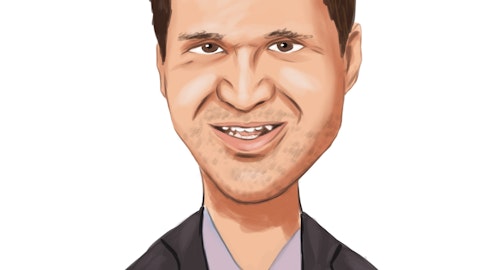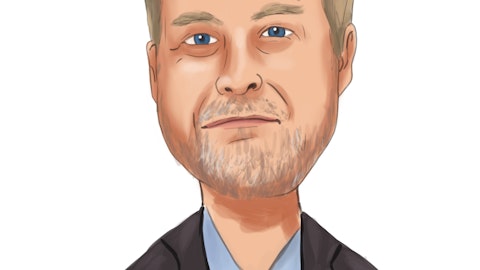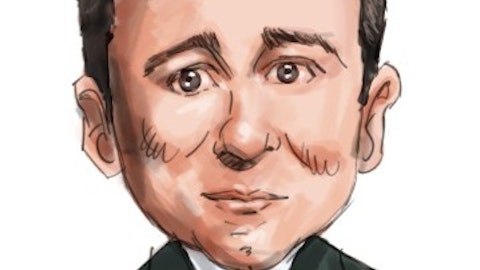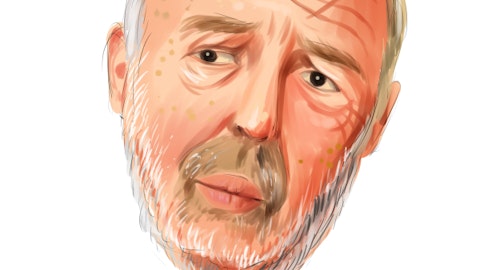Brookfield Business Partners L.P. (NYSE:BBU) Q4 2022 Earnings Call Transcript February 3, 2023
Operator: Welcome to Brookfield Business Partners’ Fourth Quarter 2022 Results Conference Call and Webcast. As a reminder, all participants are in a listen-only mode, and the conference is being recorded. After the presentation, there will be an opportunity to ask questions. I’d like now like to turn the conference over to Alan Fleming, Senior Vice President of Investor Relations. Please go ahead, Mr. Fleming.
Alan Fleming: Thank you, operator, and good morning to everyone. Before we begin, I’d like to remind you that in responding to questions and talking about our growth initiatives and our financial and operating performance, we may make forward-looking statements. These statements are subject to known and unknown risks, and future results may differ materially. For further information on known risk factors, I encourage you to review our filings with the securities regulators in Canada and the U.S., which are available on our website. Joining me on the call today are Cyrus Madon, our Chief Executive Officer; Denis Turcotte, our Chief Operating Officer; and Jaspreet Dehl, our Chief Financial Officer. Cyrus will start with an update on our strategic initiatives, and Denis will then discuss progress on our business improvement plans.
Jaspreet will finish with a discussion of our results, and then we’ll be available to take your questions. With that, I’ll pass the call over to Cyrus.

Cyrus Madon: Thanks very much, Alan. Good morning, everyone. Thanks for joining us on the call today. 2022 was a great year for our business. We made excellent progress on our growth and capital recycling initiatives, committing $2.7 billion to acquire several high-quality market-leading businesses that should contribute meaningful value to our business. We also generated $2.3 billion from distributions and business sales, including an agreement to sell Westinghouse. We’re also pleased with our solid financial performance, continued resilience of our operations. Adjusted EBITDA increased to $2.3 billion and free cash flow increased to a record $3.40 per unit for the year. Stepping back, like many, our business has experienced a lot of volatility in the operating environment over the past year.
Inflation has been persistent. Supply chains continue to be stretched, labor markets remain tight, and energy costs in many developed markets we operate in are far higher than a year ago. We all know that interest rates are also higher and global growth is decelerating. Despite this backdrop, our business has continued to perform very well. Adjusted EBITDA is up 30%, compared to last year and up 3% on a same-store basis, which after adjusting — is after adjusting for the impact of acquisitions and dispositions. Our EBITDA margin has also continued to improve to a record 19%, up from 11% just three years ago. This improvement is driven by both the quality of the businesses we’ve been acquiring over the last few years and the progress we’ve achieved on our improvement plans.
And Denis is going to talk to you about that more, shortly. The value we’re building in our business contribute to adjusted free cash flow of $740 million, an increase of nearly 20% on a per unit basis, compared to last year. We’ll use this cash flow to fund our growth, reinvest in our operations and pay down debt. As we look forward, our business should continue to generate strong performance in all market environments. Our balance sheet is also in good shape, and we ended the year with — over $9 billion of available liquidity across our operations. At the corporate level, we’ve drawn on our credit facilities to bridge the timing of our growth activities. This is temporary knowing that at some point, we’ll be in a position to repay these borrowings with the proceeds we expect to generate from our capital recycling activities.
And to that point, as many of you know, we reached an agreement to sell Westinghouse last year. We’ll generate about $1.8 billion in proceeds for BBU when the sale closes in the next few quarters, which will substantially reduce our borrowings at the corporate level. This sale also demonstrates that even in difficult markets, high-quality businesses, like many we own today are readily salable especially to strategic buyers. At any given time, we are progressing sales process for a handful of our businesses, several of which are substantial, which will be sold in due course and generate significant proceeds for BBU. While we’re pleased with our business fundamentals, we’re equally disappointed in our trading price performance, which has become materially disconnected from the value of our business.
I thought, I wanted to put that in context. Today, we’re trading at about 8 times annual EBITDA. This is a massive discount to the S&P 500 that’s trading at 13 times and businesses generating margins on par with ours that are trading at 15 times or more. In our view, it’s a great entry point for BBU. We’re going to continue building value in our business as we execute on our improvement plans. And as a result, investors should out earn the underlying performance of our operations as the discount between our trading price and intrinsic value narrows. With that, I want to hand it over to Denis.
Denis Turcotte: Thanks, Cyrus, and good morning, everyone. The core capability of our organization is the ability to provide incremental support to our portfolio companies and even take a hands-on approach as required to ensure systematic focus and adjustments to changing economic conditions. With that in mind, I wanted to spend a few minutes today providing an update on the progress we’ve achieved at a few of our businesses over the last year, illustrating in more detail how we do this. Last July, we acquired CDK Global, the leading provider of technology and software services to automotive dealers. Our value creation plan for the business is straightforward. Adjust the commercial strategy to refocus CDK on the core product and service offerings that drive the most value for its customers and improve the efficiency and effectiveness of its operations by adjusting the organizational structure, reengineering a few core processes and introducing a new cadence of focus and execution.
Fundamentally, this is same strategy we executed at Westinghouse and other portfolio companies, which enabled us to generate a step change in the business and phenomenal returns on our investment. We have made tremendous progress at CDK within the first six months of acquiring the business. To provide some specifics, we’ve organized the core team of Brookfield personnel and established a transformation team with management to ensure focus and intensity. Through the closing process, we recruited and redesigned the organization to be in a position to appoint a new senior leadership team immediately after closing and within several months, rightsized the organization by global headcount by 15%. We’ve also sold or exited some noncore product and service offerings and are working closely with management to optimize the customer product and service offerings.
While there is still more to come, the steps have already — we’ve already taken are targeted to improve the business’ EBITDA by approximately $200 million annualized once fully implemented. After adjusting for the impacts of these improvements, our buy-in multiple of less than 10 times pro forma EBITDA is exceptional value for a high-quality, market-leading software and technology business. We’re now pivoting our focus on modernizing the business’ technology stack and improving its user interface and functionality, which will enhance the value of CDK’s solution to its customers. Moving to our investment in Nielsen, the global leader in third-party audience measurement across all forms of media. As a reminder, we privatized the business alongside our partner last October.
Since then, we have worked closely with our partners and management and made considerable progress supporting the business’ advancement of our value creation plans to improve profitability and position for long-term growth. Last month, the business reached a critical milestone with the launch of Nielsen ONE Ads. It’s cross media measurement service, which unifies audience measurement data for advertisers across all platforms and devices. The business is also focused on enhancing its existing ad-supported streaming capabilities. Recent customer wins such as Netflix with its new ad-supported video tier, our validation of Nielsen’s value proposition as the leader in third-party audience measurement. In addition, we are working on several work streams to improve Nielsen’s operational efficiency and optimizing its organizational structure, resulting in significant cost reduction and a more focused go-to-market strategy.
Apart from our recent acquisitions, we’re making similar progress in other areas of our business. Everise, our business process outsourcing company is a great example. In just over two years, we have built considerable value by scaling the businesses servicing capabilities by growing revenue and increasing margins through increasing headcount by more than 50% and shifting a significant portion of its delivery capabilities to lower-cost offshore locations. We’ve also executed on meaningful cost reduction initiatives around IT, human resources in certain areas and facility management costs, while growing the business’ addressable market in the health care sector to cater to adjacent sectors, including providers, health systems and distributors.
The impact of these improvements has contributed to more than a doubling of EBITDA in the two years, since we’ve owned the company and it continues to grow. This is another great example of how we build value across the sectors and regions in which we operate through the application of our playbook and the systematic approaches that focus on adjusting product and market strategies to dynamic market conditions, reducing business model complexity, reorganizing to simplify operations, eliminating non-value-added activities and driving supply chain improvements to improve margins and optimize the capital deployed in these businesses, all ultimately driving cash flow return on investment. With that, I’ll hand it over to Jaspreet, and I’ll be available for questions later.
See also 12 Countries that Export the most Tobacco and 25 Fastest Cars in the World.
Jaspreet Dehl: Thanks, Denis, and good morning, everyone. We generated strong financial performance in 2022. Adjusted EBITDA increased to $2.3 billion, compared to $1.8 billion in 2021 with strong results across each of our three operating segments. Adjusted EFO, excluding gains, increased 15% to $1.3 billion during the year. Our Industrial segment generated full-year adjusted EBITDA of $879 million, compared to $713 million in 2021. Adjusted EFO was $473 million and included a $29 million after-tax net gain on the sale of — on the partial sale of public securities. Some of the businesses — I’ll highlight some of the business’ performance within the Industrial segment. Our advanced energy storage operations generated adjusted EBITDA of $482 million for the year.
Overall, volumes benefited from increased demand for higher-margin advanced batteries and a recovery in original equipment manufacturer demand as auto production challenges continue to ease during the year. Pricing actions and progress on our operational improvement plan helped to offset the impact of inflationary headwinds, particularly later in the year as ongoing price actions caught up to higher input costs. Our Engineered Components manufacturing operations generated adjusted EBITDA of $141 million. Performance benefited from commercial initiatives and cost reduction despite volume softening in North America and Europe. The business is focused on fully integrating its recent add-on acquisitions to drive efficiency, scale and value creation.
Moving to Infrastructure Services. Adjusted EBITDA for the year was $872 million, compared to $613 million last year. Adjusted EFO increased to $513 million, compared to $396 million. Lottery Services generated $98 million of adjusted EBITDA in 2022. Demand has been stable and the business continues to execute on initiatives to offset inflationary cost headwinds, including increased material costs. Recent customer wins are supporting an improving outlook for the business, and we expect to largely complete our carve-out activities during the first half of this year. Our nuclear technology services operations generated strong performance in 2022, contributing $314 million to adjusted EBITDA. Performance was in line with expectations. Modular building leasing services contributed $158 million of adjusted EBITDA.
Utilization levels supported by increased demand in Germany and Asia Pacific more than offset softer market conditions in the U.K. The business recently closed the acquisition of a leading rental provider in the U.K., which increases the scale and diversification of its product offering in the region. And finally, our Business Services segment generated 2022 adjusted EBITDA of $722 million, compared to $561 million last year. Adjusted EFO increased to $508 million in 2022. Our residential mortgage insurer had a strong year, generating $277 million of adjusted EBITDA in 2022 driven by higher levels of premiums earned and low claims on losses. During the year, the business provided us with approximately $200 million in dividends. While claims and losses are expected to increase from historically low levels, the business should continue to generate positive earnings and cash flow as housing market normalizes.
Our dealer software and technology services operations generated adjusted EBITDA of $89 million in 2022. Strong subscription-based revenue growth and progress on our value creation plans are contributing to improved margin performance. Healthcare Services operated in a challenging environment during the year, contributing $64 million to adjusted EBITDA. Performance was impacted by temporarily high rates of surgery cancellations and higher operating costs as Australia dealt with its flu season and the pandemic. We ended the quarter with $1.6 billion of liquidity at the corporate level, which provides us with ample capacity to support our operations. I thought I’d end with a few comments on our capital structure. Today, we have about $15 billion of proportional net borrowings across our business, which includes our proportionate share of nonrecourse borrowings within our operation.
Based on our current hedge position, a 50 basis point increase in overnight borrowing rates would result in less than a $50 million in our annual interest expense, which we believe is readily manageable with the cash flows our operations generally. As our operations delever and we repay a portion of our corporate borrowings when the sale of Westinghouse closes later this year, the impact will be more muted. With that, I’d like to close our comments and turn the call back over to the operator for questions.
Q&A Session
Follow Brookfield Business Partners L.p. (NYSE:BBU)
Follow Brookfield Business Partners L.p. (NYSE:BBU)
Operator: Certainly. And our first question comes from the line of Gary Ho from Desjardins. Your question, please.
Gary Ho: Great, thanks and good morning. Cyrus, can you give us an update on the monetization plans over the next 12 to 18 months? You’ve mentioned Clarios in your letter to shareholder, what market conditions do you need to see that IPO? And maybe also touch on Everest that’s been in the news as well.
Cyrus Madon: Yes. Look, I wouldn’t want to comment on anything specific. I will just say that you should expect we are constantly evaluating businesses that have reached a state of maturity for eventual sale and constantly testing the market. Obviously, we’re not going to sell anything or IPO anything unless we get a value that makes sense for us relative to the earnings and the intrinsic value of the underlying business. So specific to those two businesses, I wouldn’t want to say anything more than that. I think what we’ve said to you about Clarios, just to clarify that, we’re making great progress on many fronts and the business continues to improve its position as a potential candidate for an IPO. To get there, we need and want to do some things within the business to strengthen its position.
We’re making great progress in doing so. We also want to deleverage the business, and that’s underway given just how strong the cash flow generation of the company is. We’re not there yet, but we’re making good progress.
Gary Ho: Okay. Great. And then maybe as a follow-on to that. Looking out, are you spending more time on a monetization opportunities over deployment into new investments or vice versa?
Cyrus Madon: Well, today, we’re constantly looking at monetization opportunities, constantly looking at acquisition opportunities. But where we’re really focused today is on all the businesses we bought over the last year, 18-months. As you know, we’ve added a number of great companies to BBU, and we’re really focused on enhancing the value of those businesses, implementing our operating plans. That is our number one priority today.
Gary Ho: Okay. That’s very helpful. And then maybe I can sneak in one more. You’ve been very clear on your valuation disconnect message in the Investor Day and also today in your prepared remarks. What else can you guys do to help narrow the gap versus the intrinsic value? And would you be open to maybe publishing a quarterly NAV or — at some point? Or anything else that you’re thinking?
Cyrus Madon: Gary, it’s a great question. It’s one we — as you can imagine, we agonize over every day here. We really are frustrated and we realized that our shareholders, our unitholders are more frustrated, because we see the value of the business improving and the discount to NAV just getting wider. Look, we don’t think publishing a quarterly NAV will actually make any difference. And I think what we need to do is just continue demonstrating that the businesses we own are super resilient and that we’re continuing to generate increasing EBITDA and cash flow and therefore value. And ultimately, as sentiment shifts in the market and the fear of recession is no longer there, we think that will probably create the catalyst for a step change improvement in our valuation multiple.
And obviously, as we grow, we will also increase our float and that will help a lot, too. But I don’t think a NAV publication is going to make a — more regular NAV publication, it’s going to make a difference.
Gary Ho: Okay, great. Thanks, Cyrus. Thanks for sharing your thoughts. That’s it from me.
Operator: Thank you. Our next question comes from the line of Jaeme Gloyn from National Bank. Your question, please.





